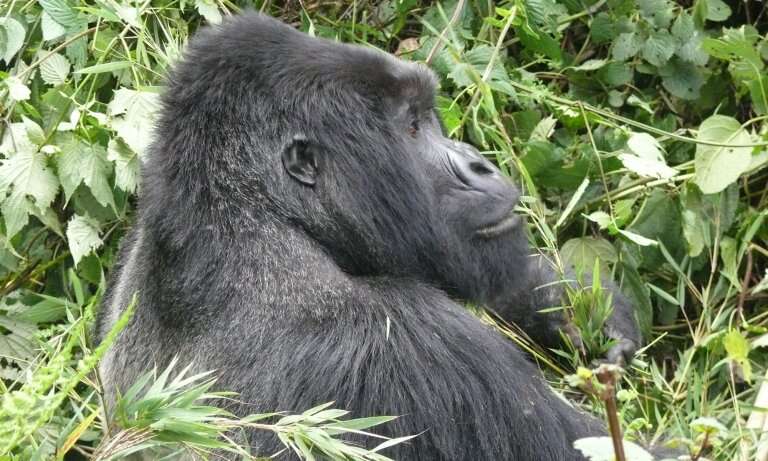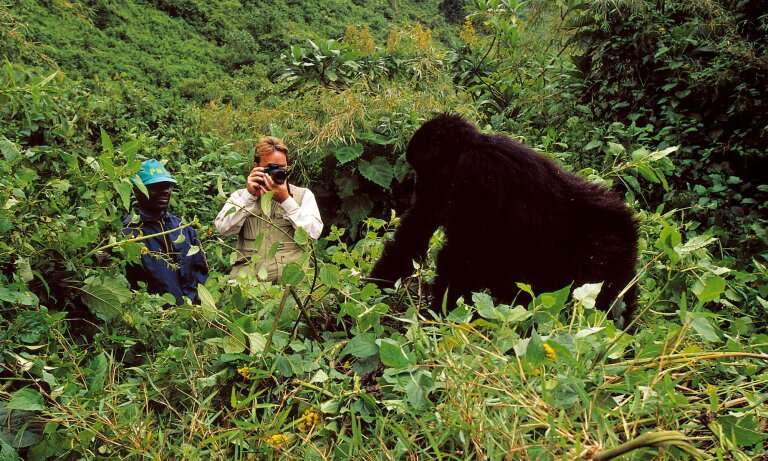Behind the mask: In search of gorilla-friendly tourism

Rwanda, land of a thousand invisible hills. It's an overcast morning in Kigali, capital of Africa's most densely populated country. The sound of a bamboo broom scraping the tarmac accompanies a solitary sweeper engaged in the Sisyphean task of keeping the hotel frontage spick and span. Overhead, a black kite looms into view. Then another, then a third, swooping down like dementors out of the mist. The drabness of the scene is relieved by the iridescent headgear of a diminutive sunbird, scolding the universe from a nearby palm frond.
A distant sound like muffled applause heralds the approach of rain. It begins as half-hearted drizzle and builds rapidly in a crescendo until the decibels of the downpour drown out all other noise. Before long, the road has been transformed into a river. This is meant to be Rwanda's short dry season, but our unhinged climate clearly has other ideas.
I'm here to attend a series of workshops on behalf of Fauna & Flora International (FFI), to help fine-tune the latest communications strategy for the International Gorilla Conservation Programme (IGCP), a partnership that has been working to safeguard mountain gorillas for more than 40 years. The wide-ranging discussions will cover community engagement, the threats posed by infrastructure developments and—top of the agenda—tourism best practice.
The patient and painstaking habituation of mountain gorillas to the presence of humans has given us tourist-friendly gorillas and—for the fortunate few who can afford the price of a permit—furnished a memorable wildlife-watching experience that shows no sign of diminishing in popularity. It's the gift that keeps on giving. And yet…
Like other great apes, mountain gorillas are highly susceptible to human-borne diseases. Even a common cold, which is little more than a temporary inconvenience for humans, could prove fatal to them. With coronavirus in the news and the dangers of disease transmission dominating the headlines, we need to acknowledge that human-borne infections pose one of the most serious threats to the survival of mountain gorillas—and to strain every sinew to minimise that risk.

DON'T STAND SO CLOSE TO ME
One of the most pressing issues discussed at the IGCP workshop was the need to ensure that a minimum distance is maintained between visitors and gorillas and—given that the apes are oblivious to these rules of engagement—the importance of taking extra precautions to legislate for those moments when gorillas make it impossible to observe the guidelines. Foremost among these additional measures is the use of a mask or other form of protective barrier to cover the nose and mouth throughout the one-hour duration of a gorilla encounter.
Responsible tourism is the cornerstone of mountain gorilla conservation and crucial to their survival. It is the lifeblood of the national parks and generates vital revenue for nearby communities, ensuring that they recognize the value of safeguarding gorillas and their forest habitat. But it's a delicate balancing act, and the welfare of the gorillas must be paramount in all interactions between tourists and apes.
Fast-forward one week, and the workshops are behind me. I'm standing in Volcanoes National Park, staring up at the jagged peak of Mount Sabyinyo, bracing myself for a grueling climb that I hope will bring me face to face with some of the magnificent apes that have benefited from IGCP's conservation efforts. Face to face is the wrong expression, of course, and not just because it's unwise to look a 500-pound silverback in the eye. Keeping a safe distance, in order to minimize direct and indirect contact, is a sensible precaution for both parties. For the gorilla, it could be the difference between life and death.
The ongoing recovery of mountain gorillas from the brink of extinction to the point where numbers have reached four figures is a wonderful success story and a tribute to the dedication, commitment and sacrifice of everyone involved. To jeopardize that legacy by failing to take adequate precautions against disease transmission would be an act of negligence that future generations would find difficult to comprehend and impossible to forgive.
It's time to heed IGCP's call for Certified Gorilla Friendly standards to be put in practice at all mountain gorilla sites in Rwanda, Uganda and the Democratic Republic of Congo. All those in favor of gorilla-friendly tourism, say 'aye', and if it's awkward to speak through your mask, just grunt. We'll take that as a yes.
Provided by Fauna & Flora International





















